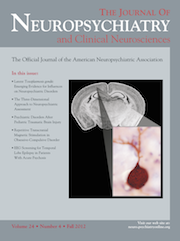Escitalopram-Related Visual and Auditory Hallucination in a Non-Dementia Patient With Depression
To the Editor: Escitalopram (the S-enantiomer of citalopram) is a kind of selective serotonin reuptake inhibitor (SSRI) for depression. Here, we report a non-dementia patient with depression, who suffered from visual hallucinations (VH) and auditory hallucinations (AH) after using escitalopram.
Case Report
The patient is a 70-year-old man who developed depression symptoms, such as depressed mood, lack of interest, lack of energy, anhedonia, insomnia, and weight loss, within the previous month (Hamilton Rating Scale for Depression [Ham-D] score: 26). No concurrent severe medical illness (including Parkinson’s disease or head injury) was noted, except hypertension. Under the impression of nonpsychotic depression, he started to receive escitalopram 5 mg/day for the first 2 weeks, and then the dose of escitalopram was titrated to 10 mg/day, given no intolerable side effects and persisting significant depression at 5 mg/day treatment. The depression symptoms improved under escitalopram therapy for 1 month (Ham-D score: 10). However, he began to see nonexistent strangers talking to him after using escitalopram for 3 days. The commands and comments were loud and clearly heard. No significant findings were found in the magnetic resonance imaging of brain. The VH is significant after using escitalopram 10 mg/day for 1 month. His Clinical Dementia Rating (CDR) score was 0.5 and Mini-Mental State Exam (MMSE) score was 23, which showed no significant evidence of senile dementia or delirium. However, he still had significant VH and AH during the escitalopram treatment. Under the impression of possible SSRI-related VH and AH, we began to taper the dose of escitalopram to 5 mg/day within 1 week and then completed withdrawal from escitalopram within 2 weeks. The VH and AH almost disappeared after withdrawal from escitalopram for 1 month. There was no relapse of depression in this case after quitting escitalopram treatment.
Discussion
SSRIs such as fluoxetine, sertraline, fluvoxamine, and paroxetine have been reported to be associated with VH.1 This patient began to have VH and AH since using escitalopram, which probably suggested the direct relationship between escitalopram and hallucinations. To my knowledge, this may be the first report about escitalopram-related VH and AH. Mowla et al.2 previously presented a case with complex VH after citalopram treatment within 2 days, and discontinuation of citalopram could relieve the citalopram-related VH. The VH and AH probably developed because of the imbalance between serotonin and acetylcholine systems. The SSRI would cause serotoninergic hyperactivity and subsequent cholinergic hypoactivity.3 This serotonin–acetylcholine hypothesis could also be supported by the Holmes et al. study4 about the serotonin receptors in neocortex and the relationship to VH symptoms. Besides the serotoninergic hypothesis, the increase of dopamine release would be another possible pathway for SSRI-related hallucinations. Lauterbach et al. also reported that SSRIs might induce psychotic symptoms through the serotonin 5HT2- and 5HT3-mediated dopamine release in ventral striate.5 Schuld et al.6 also proposed that SSRIs would cause hallucination through direct blockade of dopamine reuptake or indirectly via stimulation of postsynaptic 5HT2 and 5HT3 receptors. Based on the above literature review, escitalopram might induce the VH and AH through the modulations of serotonin, dopamine, and glutamate systems. The discontinuation of escitalopram can terminate the hallucinations.
1 : Fluoxetine and visual hallucinations in dementia. Biol Psychiatry 1995; 38:556–558Crossref, Medline, Google Scholar
2 : Citalopram associated with complex visual hallucination: a case report. Prog Neuropsychopharmacol Biol Psychiatry 2009; 33:575–576Crossref, Medline, Google Scholar
3 : Factors associated with complex visual hallucinations during antidepressant treatment. Hum Psychopharmacol 2004; 19:577–584Crossref, Medline, Google Scholar
4 : 5-HT2A and 5-HT2C receptor polymorphisms and psychopathology in late-onset Alzheimer’s disease. Hum Mol Genet 1998; 7:1507–1509Crossref, Medline, Google Scholar
5 : Dopaminergic hallucinosis with fluoxetine in Parkinson’s disease. Am J Psychiatry 1993; 150:1750Crossref, Medline, Google Scholar
6 : Visual hallucinations and psychotic symptoms during treatment with selective serotonin reuptake inhibitors: is the sigma receptor involved? J Clin Psychopharmacol 2000; 20:579–580Crossref, Medline, Google Scholar



